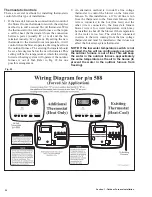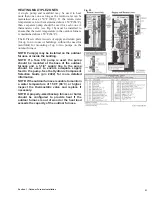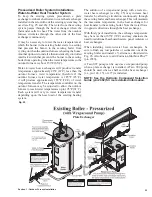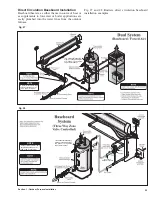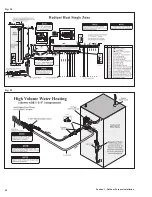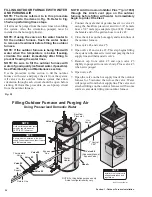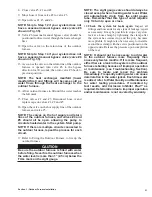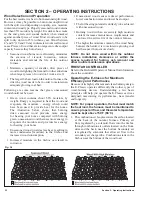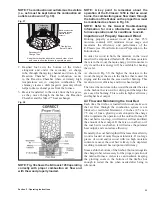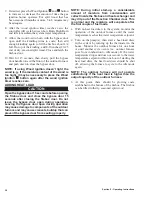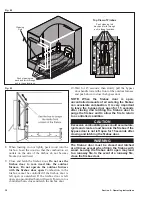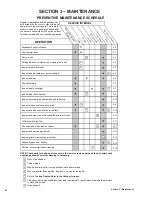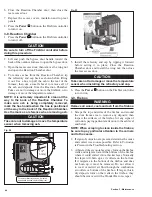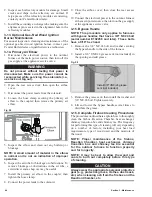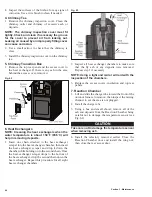
33
NOTE: The combustion air outlets must be visible
(i.e., ash must be kept below the combustion air
outlets as shown in Fig. 39).
Fig. 37
Combustion
Air Outlets
Gas Ignition
Burner Shield
Secondary Air
Charge Tube
Keep the combustion air outlets open and clear of ash
and coals to allow the furnace to operate properly.
NOTE: Combustion
air outlets are also
located in front
corners.
© 2012 Central Boiler
2. Gasified fuel exits the bottom of the firebox
alongside and under the secondary air charge
tube, through the mixing channel and down to the
Reaction Chamber
™
. Final combustion occurs
in the Reaction Chamber where extremely high
temperatures aid in complete combustion. The
chimney creates a draft (negative pressure) which
helps to draw exhaust gases from the furnace.
3. Heat is transferred to the water from the hot gases
as they move through the firebox, the Reaction
Chamber and the Xtract™ heat exchanger.
Fig. 38
NOTE: Fig. 38 shows the E-Classic 1450 operating
correctly with proper combustion air flow and
with the wood properly loaded.
NOTE: A key point to remember about the
operation of the E-Classic 1450 is that as wood
burns, the combustion gases flow down through
the bottom of the firebox so the proper flow must
be maintained as shown in Fig. 38.
NOTE: Refer to the General Troubleshooting
Information for more information on outdoor
furnace operation and for conditions to avoid.
Importance of Properly Seasoned Wood
Burning properly seasoned wood (less than 25%
moisture content) will minimize wood usage and
maximize the efficiency and performance of the
E-Classic (see Wood Selection and Preparation in the
Introduction).
In order for wood to burn, the moisture in the wood
must first be evaporated (boiled off). The more moisture
there is in the wood, the more energy it will consume to
dry it and the less energy will be available for heating
the water.
As shown in Fig. 39, the higher the moisture in the
wood, the larger the area in the firebox that is used for
drying and the smaller the area used for burning. This
results in lower efficiency and lower heat output.
The lower the moisture in the wood, the smaller the area
in the firebox that is used for drying and the larger the
area used for burning. This results in higher efficiency
and higher heat output.
Air Flow and Maintaining the Coal Bed
Each time the firebox is loaded with wood, make sure
that air flow through the combustion system is not
blocked or restricted. Maintain 1-3 inches (2.5 cm to
7.5 cm) of loose, glowing coals alongside the charge
tube to optimize the operation of the outdoor furnace. If
the coal bed is too deep, it will restrict air flow and limit
the amount of heat output. If there is no coal bed, or if
the coal bed is too shallow, it will reduce the potential
heat output, and can reduce efficiency.
Generally, the coal bed depth will increase if smaller dry
wood is loaded at more frequent intervals. If too large
pieces of wood and/or wood with too high moisture
content are used, the coal bed is likely to be depleted,
resulting in reduced heat output and efficiency.
Some ash in the bottom of the firebox (but not alongside
the charge tube) is necessary for the proper operation of
the outdoor furnace. Ash acts as an insulator, keeping
the glowing coals in the bottom of the firebox hot
enough to restart the fire when needed after being in
idle mode.
Section 2 - Operating Instructions
Summary of Contents for e-Classic 1450 IR
Page 17: ...15 Section 1 Outdoor Furnace Installation...
Page 29: ...27 Section 1 Outdoor Furnace Installation Fig 30 Fig 31...
Page 30: ...28 Section 1 Outdoor Furnace Installation Fig 32 Fig 33...
Page 66: ...64 E CLASSIC 1450 WIRING DIAGRAM Section 6 General Information...
Page 67: ...65 Section 6 General Information E CLASSIC 1450 WIRING DIAGRAM OPTIONAL POWER IGNITION...
Page 69: ...67 NOTES...
Page 70: ...68 NOTES...
Page 71: ...69 NOTES...


